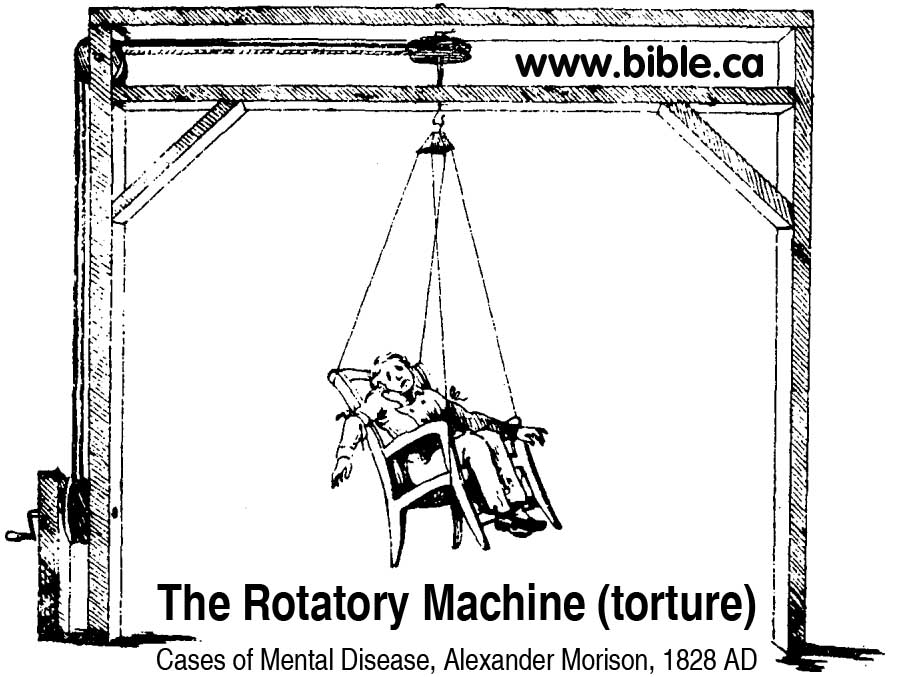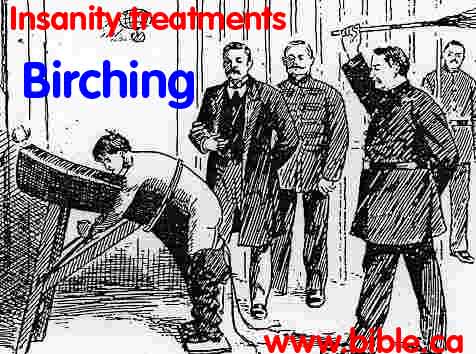How does Torture and Coercion cure inanity?
|
Insanity is a behaviour choice. Torture changes the will. |
||
|
|
||
Introduction:
- Psychiatrists have always used coercion or torture to cure insanity. Coercion is still widely used in both Canada and the USA. The use of torture came to an end about 1940.
- We are totally opposed to using any coercion or torture in the "treatment" of insanity. However, it is clear from the record of history, that torture did cure mental illness.
- The question is: "How does torture cure insanity?" The answer is simple: Insanity is a behaviour choice not a disease. The whole idea of "curing" insanity is ridiculous at its core. It is like saying that you are going to "cure" someone of chronic lying or adultery. Insanity is a behaviour just like lying and adultery. You don't cure people of behaviours with drugs, you persuade them by appealing to their conscience.
- For a chemical psychiatrist, they have no answer, or they lie and say that it does not cure. They believe insanity is a biological problem like diabetes. They have an ideological dissonance with admitting torture cures insanity. They cannot admit that torture could have any more effect on insanity, than it would on stabilizing blood sugar levels. Imagine the implications if torture cured diabetes, cancer and mended broken bones faster. Of course this is not true because these are medical conditions. So chemical psychiatrists simply cannot even admit the possibility that torture "cures" insanity because if they did, it would prove that it is a behaviour choice and not a disease.
- The word psychiatrist literally means, "a doctor of the soul" and church ministers were the first psychiatrists who specialized in working with the insane. Church ministers were the first experts in helping to change the behaviours of the insane. They correctly understood insanity as a behaviour that needed correcting like any other sins like habitual stealing, adultery or selfishness. Church ministers never tortured the insane, it was the medical mad doctors who did such.
- So very simply stated, coercion and torture "cure" insanity, because mental illness is a moral choice not a disease. Torture can change choice, but it cannot cure a disease.
A. Torture as treatment:
- see our major section on historic treatments of insanity.
- There were two types of historic treatment: Counseling and Coercion. Coercion as a treatment for insanity made its debut about 1675 AD. Gradually coercion became the dominant treatment of choice in about 1800 AD.
- "Many of the asylum doctors were no more than medically qualified gaolers [jailers], whose only attempts at "care" were the tactics of restraint and punishment so angrily summarised by Swift a century earlier. "Though 'tis hopeless to reclaim them, scorpion rods perhaps may tame them" [Jonathan Swift.]" (British Psychiatry at 150, J. Birley, Lancet, 1991 AD)
- The vast majority of medical doctors viewed as a behaviour choice but some doctors viewed the etiology of insanity as biological (chemical psychiatrists).
- Both groups of doctors practiced torture to "cure" the insane- but for two different reasons.
- For the doctors who viewed insanity as a behaviour choice, torture was used as a punitive method of changing unwanted and sinful behaviours.
- "Mad doctors and alienists" (forerunners of chemical psychiatrists) believed insanity was involuntary and caused by 1. a chemical imbalance of the four humors (bad blood) 2. bloated blood vessels 3. damaged nerves. Torture was used by the "chemical psychiatrists" because they believed that inflicting pain, starvation, isolation, inducing nausea and diarrhea with drugs and spinning machines, hypothermic cold baths, electric shocks, chemical blistering of the skin, bloodletting, foot chains and jail cells would actually bring about a change in body chemistry.
- "Spinning in chairs, rotating in swings, prolonged
immersion beneath high pressure cold showers, surprise plunges into icy
water, or lying in warm baths while cold water was applied to the head,
were all methods calculated to debilitate, shock, and soothe sanity back
into the system. The rotary treatment was apparently applied more as a
corrective, than a therapeutic treatment. "After having committed
some irrational and spiteful act, the patient is forthwith placed on the
rotating chair and revolved at adjusted speed until he becomes quiet, apologizes, and promises improvement, or
until he starts to vomit." (Cox's Chair, Nicholas J. Wade,
2005 AD, p. 77)

- In 1758 AD, vomiting was the treatment of choice! In 1758, a mad doctor at Bedlam named John Monro induced vomiting on a daily basis to remove "phlegm" and restore "humoral balance", even though he plainly admitted he had no idea what really caused insanity! This was the science of the day. But at the same time, another mad doctor named William Battie used most of these same methods. Battie tells us that for him to reject vomits as a cure, would be considered heresy. Indeed, of all the treatments of the 1750's, vomits was viewed as the cure of choice! Battie believes that mental illness is caused by a clogging of brain and nerve matter and he tells us that the reason vomits cures, is entirely in the physical convulsions associated with vomiting. The violent convulsive action of throwing up, with the increase of blood pressure to the brain and the stress to the eyes and nervous system, is like using carburetor cleaner in your engine to clean out the gunk and loosen everything up! This bizarre quackery began to replace the historic view that insanity was a behaviour until 1858 AD when the cell was discovered!
- "Punishment, either corporal or mental, was an important aspect of the treatment of insanity for several thousand years. It was apparently first used to drive out—or kill—the evil spirit that was believed to have taken possession of the psychotic person. Its use persisted even into the nineteenth century, after the treatment of insanity was supposed to have become humane, but at that time it was justified on different grounds. Lichtenberg, for example, recommended it because, he said, "the rod helps God" and because in the beaten patient "the soul is forced to knit itself once more to that world from which the cudgels come." (Roots of Modern Psychiatry, Mark D. Altschule, 1965 AD, p 142)
- Mad doctors in 1758 like William Battie, confidently claimed they knew the cause of mental illness was brain and nerve damage. He was totally wrong! Yet this same etiology of mental illness being "broken brains" is still used today by psychiatrists. Both historic mad doctors and today's psychiatrists boldly claim to know the cause of mental illness and the public blindly believes them! The historic etiology of nerve damage has been replaced with chemical imbalances but both are mythical, theoretical and unobserved in science.
- So in 1758 AD, two chemical psychiatrists (Monro and Battie) treated the insane with torture for two different reasons. Monro claimed he had no idea what caused mental illness, but believed that removing "bad humoral body fluids" would help. On the contrary, Battie claimed clogged nerves was the definite cause of mental illness and believed the physical convulsions associated with vomiting, would "shake up the nerves" and restore sanity! So these two mad doctors practiced "vomits" to cure mental illness, but one to remove phlegm and the other to shake up the nerves! Both these quacks are the forerunners of all modern psychiatrists today!
- The fact is that chemical psychiatry has never understood what causes mental illness or how to cure it! Church ministers being the first experts of insanity, have always correctly understood mental illnesses as behaviours of choice. Today psychiatrists should take a counseling course from church ministers!
|
Who |
Cause |
"Treatment" |
Why? |
|
Church ministers |
behaviour choice |
counseling |
counseling can bring about a change of will and a corresponding change in the insane behaviour. |
|
medical doctors |
behaviour choice |
torture |
Punitive like a public whipping to change unwanted behaviour |
|
chemical psychiatrists |
humoral imbalances, bloated blood vessels as and damaged nerves |
torture |
Altar body chemistry, physically shaking the brain and body would restore normal function |
B. Why Torture cured insanity:
|
Psychiatry has made no advances since the mad doctors and their asylums of the 1750's. The science of psychiatry today, is in fact identical to the mad doctors of Bedlam in 1750 AD. Today's psychiatrists have no more idea about the etiology or cure of mental illness then their mad doctor colleagues three centuries before them. Neither have any idea what causes mental illness and neither have any cures to offer. In Bedlam they used shackles and jail cells to physically restrain people and to coerce them into changing their unwanted and annoying behaviours. Today the shackles and bars have been replaced with drugs and shocks. Instead of people being restrained in a single place, drugs are the modern chemical restrains that allow the insane to roam around in public. In 1750, their body was in chains in a little jail cell, in 2011, their mind is in chains while they roam free. |
- It is important to remember that insanity is a behaviour choice and speaking of a "cure" of insanity is as ridiculous as speaking of a cure of chronic lying. However it is clear that torture indeed "cured" the insane of their unwanted behaviours.
- One key observation is that the mad doctors of the 1750's agreed that isolation, incarceration and vomits indeed cured mental illness. It is clear they had no idea why this worked, but they observed that these methods cured mental illness.
- The fundamental approach of historic psychiatry to cure the insane, was to make their lives so miserable that they change their behaviours in order to escape the treatment.
- "[John Burdett] Steward called the treatment [vomits swing] barbarous. He said (1845): "It is a remedy which would be tolerated in no disease but insanity. Unless tried, it is quite impossible to conceive the suffering produced by it. The author speaks confidently from having himself tried it." (Roots of Modern Psychiatry, Mark D. Altschule, 1965 AD, p 149)
- "British psychiatrist William Sargant (1907-1988) approvingly observed: "The history of psychiatric treatment shows, indeed, that from time immemorial attempts have been made to cure mental disorders by the use of physiological shocks, frights, and various chemical agents; and such means have always yielded brilliant results in certain types of patients." He attributed the practice of tormenting-as-treatment to its alleged effectiveness in "curing mental disorders." I attribute it to the human proclivity for sadism. Whatever its ultimate source may be, the torturing of mental patients and rationalizing it as treatment has characterized the practice of psychiatry from its earliest days to the present." (Coercion as Cure, Thomas Szasz, 2007 AD, p 65)
- We believe that isolation, incarceration and vomits really did cure mental illness, but not for either reason they give. Some other mechanism must be present. The reason seems obvious. Since mental illness has no etiology in the physical body, but is entirely a "spiritual sickness", isolation, incarceration and vomits made the "patients" life so miserable, he cured himself in order to escape! This may appear as bizarre as bloodletting to people today, but this simple answer is correct!
Conclusion:
- The practice of psychiatry today with its theoretical chemical imbalances of the brain and Neuroleptic drugs is as much quackery as the mad doctors in 1750 AD who prescribed daily vomiting and bloodletting as the best cure for mental illness. The general public gazed on in trusting ignorance of their expert's knowledge.
- Today, the same curtain of delusion covers the general public with the latest set of theories put forth by the chemical psychiatry industry. In 2100 AD, the present psychiatric theories for the causes and cures of mental illness will be viewed as much quackery as vomiting and bloodletting of days past.
- Whether shackled into submission, jailed into submission or drugged into submission, society always finds a way of controlling those who chose to be uncontrollable. Mad doctors of the 1750's knew that if you make the lives of mentally ill difficult, you would cure a lot more than if you made their stay like a pleasant vacation. They also knew that much of the mental illnesses they treated were malingering (faked mental illnesses) and completely under the control of the patient.
- Isolation, incarceration and vomits indeed cured insanity and "hysteria" although such is clearly a violation of civil rights unless criminal laws are broken.
- Punishments will clearly modify unwanted behaviour that society finds offensive, repulsive or annoying. The history of psychiatry is the clinical study that has proved this point beyond question.
- Any criminal behaviour of those who are insane should be dealt with by courts, judges and jails.
- Church ministers both then and today reject such physically punitive psychiatric treatments as torture, immoral and sin. If a person engages in sinful behaviour, the Christian warns of God's judgement and asks the insane to change his behaviour. If they chose not to stop acting like a mad man, but do not commit crimes, then they should be left alone and free to behave any way they want. God is the final judge.
- Obedience to Jesus Christ is the only "cure" for the sinful behaviours associated with insanity.
- Society has 4 methods of
teaching you to behave:
1. your mother (suspending your freedom by grounding you to your room and spankings)
2. your church minister and the bible (appeal to will and conscience)
3. the jail (suspending your freedom)
4. the psychiatrist (drugs, shocks to the brain and suspending your freedom in asylums) - From a parenting point of view, grounding and spankings clearly "cure" children of disobedient behaviours. From a criminal law point of view, monetary fines, jail and whippings clearly "cure" criminals of their illegal behaviours. From a psychiatric point of view, coercion and torture clearly "cure" the mentally ill of behaviours that others in society find offensive, annoying or distasteful.
- The fundamental approach of historic psychiatry to cure the insane, was to make their lives so miserable that they change their own behaviours in order to escape the treatment. The insane cured themselves because the alternative was more jail, nausea, vomits, blisters, starvation diets and painful blisters.
- Although the efficacy of torture to "cure" mental illness is beyond dispute, it is immoral and a violation of civil liberties, unless criminal laws are broken, then it is a matter for the police, courts and jails. Otherwise the insane should be free to live and move about us with their delusions and paranoia's. However the Bible says, "if a man will not work, neither let him eat". The state should also not be directly supporting anyone who is unwilling to work.
- All this proves that insanity is a behaviour choice, not a disease and that psychiatry is a duplicate penal system to control those behaviours that society find offensive, bothersome or annoying.
By Steve Rudd: Contact the author for comments, input or corrections.
Send us your story about your experience with modern Psychiatry



